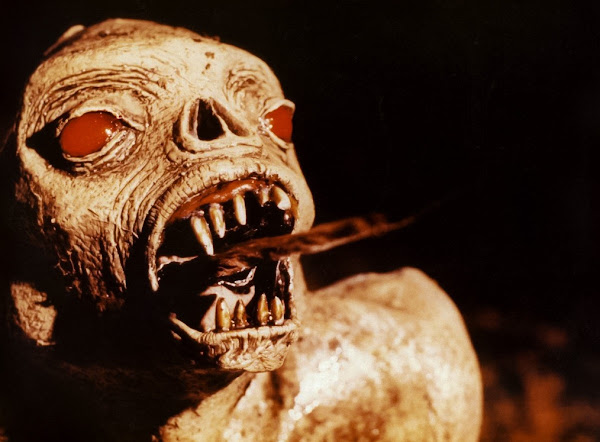EDIT 27/09/2024: I recently interviewed Francis Coates about his work on Xtro, as well as touching on his work on other genre productions as a sculptor and modelmaker. You can read it here!
'To do the most disgusting things that we could possibly get away with' was director Harry Bromley-Davenport's imperative for Xtro. To this end Davenport hired newer actors from theatre and television rather than star actors, to let the budget mainly go to effects.
Francis Coates, a sculptor who had worked for the BBC and White Horse Toy Company, was credited under 'Creature Effects'. Assisting Coates was Richard Gregory, who ran the freelance effects company Imagineering, and credited under 'special effects operator'.
Robin Grantham was credited as 'makeup supervisor', with John Webber credited as 'additional special makeup effects makeup'. It can be assumed that Grantham and Webber handled Philip Sayer's and Simon Nash's transformators towards the end of the film.
Coates and Grantham both worked from designs by Christopher Hobbs, credited under 'visual consultant'. Hobbs, a production designer, had also visualized (on paper) the gruesome effects sequences in Ken Russell's The Devils and Neil Jordan's The Company of Wolves.Family man Sam Philips, abducted by a UFO, returns to Earth as a scuttling alien. It was Francis Coates who decided the alien should walk on all fours, as he was tired of all the monsters he'd made on Doctor Who that were performers walking upright in masks.
Crawford got the better end of the deal as all he was required to do was wear a large static mask (fabricated by Coates & Gregory) and army fatigues, and walk around a set.
Meanwhile Dry was subjected to a life casting of his body in the crab walking position (a photo of which can be found on Coates' website) for the foam rubber suit to be sculpted around, and then for the actual filming had to crabwalk in a damp forest at night while wearing the suit! Some close-up shots required the monster to flick its tongue out, or for a phallic tendril to snake out of its chest. Coates, in my interview, said there was no close-up prop due to the lack of budget, but this one behind the scenes photo makes me wonder if he was misremembering. Note the short stubby arms and the way it's shot in close-up.Coates' sculpture must have been used to at least make *one* recasting for an 'empty' latex skin, after the monster has impregnated an unlucky Susie Silvey.
For when Philip Sayer is rebirthed, a (possibly gelatin?) fake umbilical cord prop was also made, for him to bite apart. Not many behind the scenes images of this sequence!
More advanced latex prosthetics were made for Simon Nash's and Maryam D'Abo's alien infections. According to Coates, this was Richard Gregory's work, and he explained how the effect was achieved;
'We (made) a body with very thin latex channels inside them, pretty much invisible. (...) we made these ball bearings ('eggs') and pushed these ball bearings along these so-called veins to make them stand up. (...) The third stage, we just used a suction pump so that the tubes just disappeared from her body, but the 'eggs' stayed'.
It seems that a gelatin mask must have been made from the same sculpt, patched up with hair, and placed over the skeletal alien puppet. Perhaps a hairdryer was used to make it melt, as usual for melting gelatin head effects since Raiders of the Lost Ark?
- 'Xtro Xposed' interview with Harry Bromley-Davenport
- Fangoria issues #19 and #24
- Famous Monsters of Filmland issue #191
- Rod Serling's Twilight Zone Magazine, December 1982
- Francis Coates' official website: http://www.scopedesign-uk.com/

























































